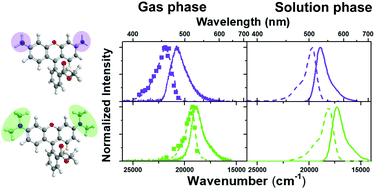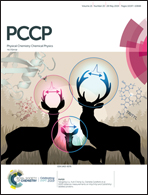The effect of methylation on the intrinsic photophysical properties of simple rhodamines†
Abstract
The rational design of rhodamines and other fluorescent probes for different functions would benefit from an improved understanding of their photophysics. Key photophysical properties, including fluorescence, depend on the outcome of competing pathways for intra- and intermolecular energy flow within and from excited state molecules. In the work reported here, we simplify this complex landscape by eliminating solvent interactions, revealing intrinsic photophysical effects of systematic structural changes. Selected-ion laser-induced fluorescence (SILIF) is used to examine the effects of stepwise N-methylation on a rhodamine scaffold, starting with the simple rhodamine 123, in the gas phase. Fluorescence excitation and emission spectra together with fluorescence lifetime measurements are reported and discussed. While the systematic decrease in gas-phase 0–0 transition energy by 500 cm−1 per methylation is in line with expectations from solution studies, other trends are observed that are not apparent in solution studies. These include a notable narrowing of spectral profiles, three-fold decrease in Stokes shift and an ∼three-fold increase in brightness as the number of N-methylations rises from zero to four. Most surprising, while rhodamine 123 displays the expected textbook mirror-image symmetry between excitation and emission spectra, the emission spectrum of its tetra N-methylated derivative is ∼30% broader than the excitation spectrum. The likelihood that this difference reflects emission prior to complete vibrational redistribution of energy within the excited state of the larger rhodamines is discussed. This suggestion goes against conventional wisdom about the timescale of energy redistribution within molecules of this size, an understanding which was developed from solution studies. Overall, this study furthers our understanding of energy flow within an important class of fluorophores, highlights the consequences of energy flow between fluorophores and surrounding solvent, and provides benchmark experimental data for solvent-free chromophores to assist and calibrate computational work.

- This article is part of the themed collection: 2019 PCCP HOT Articles


 Please wait while we load your content...
Please wait while we load your content...